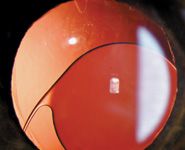Article
Dislocation, decentration concerns for foldable IOLs, survey finds
San Francisco-The most common complications involving foldable IOLs and requiring explantation showed little change over the past 2 years, according to an annual survey sent to members of the American Society of Cataract and Refractive Surgery (ASCRS) and the European Society of Cataract and Refractive Surgeons (ESCRS).

The complications depend on the type of IOL implanted and most involve dislocation and decentration, reported Nick Mamalis, MD, at the annual meeting of the ASCRS.
Dr. Mamalis explained that the survey was carried out through the Cataract Clinical Committee of ASCRS. A form was developed and sent to surgeons to compile data on the signs and symptoms of the patient, the preoperative visual acuity, and the complications requiring a secondary intervention.

The investigators considered the IOLs by type and determined the most common complications associated with each, he explained. Dr. Mamalis is professor of ophthalmology, John A. Moran Eye Center, University of Utah, Salt Lake City.
"When we looked at three-piece silicone IOLs, we found that dislocation/decentration occurred in almost 70% of the cases requiring explantation," Dr. Mamalis said. "With plate-type silicone IOLs, dislocation/decentration occurred even more commonly-in more than 90% of cases requiring explantation."

The hydrophilic acrylic IOLs and the one-piece hydrogel IOLs are in a class by themselves, in that they are associated with different complications compared with the others. Calcification or damage to the IOL in the three-piece designs is the most common reason that these lenses are removed. The one-piece hydrogel IOLs sustain damage, because, Dr. Mamalis explained, these lenses are more fragile than the others.
The complications with multifocal silicone IOLs are about evenly split between dislocation/decentration and incorrect lens power. In commenting on these findings, Dr. Mamalis said that preoperatively there is a substantial loss of visual acuity in many of these patients.

"Dislocation/decentration are by far the most common reasons for removing foldable IOLs in the most recent survey," he said. "That was followed by incorrect lens power and damage to the IOL necessitating removal."





